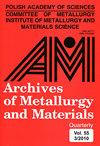The Effect of Addition Amount of Chromium Iron on the Bonding Strength between Alloy Steel Surfacing Layer and Steel Base Metal
IF 0.7
4区 材料科学
Q4 METALLURGY & METALLURGICAL ENGINEERING
引用次数: 0
Abstract
Fe-C-Cr-Nb alloy steel surfacing layers with different contents of C and Cr were prepared on 45 steel base metal by selfshielded flux-cored wires with distinct amounts of high carbon chromium iron addition and melt arc surfacing. The composition and microstructure changes of the surfacing layer were tested and analyzed. The surfacing test plate was processed into a pulling specimen, and the bonding strength between the surfacing layer and the 45 steel base metal was tested with a self-designed pulling test method. The fracture location of the pulling specimen and fracture characteristics were observed by a metallurgical microscope and a scanning electron microscope. The result shows that with the increase of the amount of high carbon chromium iron added to flux-cored welding wire, the content of C and Cr in the surfacing layer increases, and the NbC hard phase disperses. The microstructure of the steel matrix changes from mixed martensite + residual austenite to high carbon martensite + residual austenite, and then independent austenite appears. The hardness of the surfacing layer first increases and then decreases. The bonding strength between the surfacing alloy and the 45 steel base metal first decreases and then increases, and the fracture location is at the bottom of the surfacing layer or the fusion zone with mostly quasi-cleavage characteristics. When the additional amount of high carbon chromium iron reaches 13%, thee pulling specimen exhibits significant deformation with the highest bonding strength, and the fracture is close to the fusion line, where there are numerous tearing edges and shallow dimples.铬铁添加量对合金钢堆焊层与钢基体之间结合强度的影响
通过添加不同量高碳铬铁的自屏蔽药芯焊丝和熔融电弧堆焊,在 45 钢基体金属上制备了不同 C 和 Cr 含量的 Fe-C-Cr-Nb 合金钢堆焊层。对堆焊层的成分和微观结构变化进行了测试和分析。将堆焊试板加工成拉拔试样,采用自行设计的拉拔试验方法测试堆焊层与 45 钢基体金属之间的结合强度。金相显微镜和扫描电子显微镜观察了拉拔试样的断裂位置和断裂特征。结果表明,随着药芯焊丝中高碳铬铁添加量的增加,堆焊层中 C 和 Cr 的含量增加,NbC 硬相分散。钢基体的显微组织由混合马氏体+残余奥氏体转变为高碳马氏体+残余奥氏体,然后出现独立奥氏体。堆焊层的硬度先升高后降低。堆焊合金与 45 号钢基体金属之间的结合强度先减小后增大,断裂位置位于堆焊层底部或熔合区,大多具有准脆性特征。当高碳铬铁的添加量达到 13% 时,拉拔试样出现明显变形,结合强度最高,断口靠近熔合线,出现大量撕裂边缘和浅凹痕。
本文章由计算机程序翻译,如有差异,请以英文原文为准。
求助全文
约1分钟内获得全文
求助全文
来源期刊

Archives of Metallurgy and Materials
工程技术-冶金工程
CiteScore
1.20
自引率
0.00%
发文量
0
审稿时长
4.5 months
期刊介绍:
The Archives of Metallurgy and Materials is covered in the following Institute for Scientific Information products: SciSearch (the Science Citation Index - Expanded), Research Alert, Materials Science Citation Index, and Current Contents / Engineering, Computing and Technology.
Articles published in the Archives of Metallurgy and Materials are also indexed or abstracted by Cambridge Scientific Abstracts.
 求助内容:
求助内容: 应助结果提醒方式:
应助结果提醒方式:


